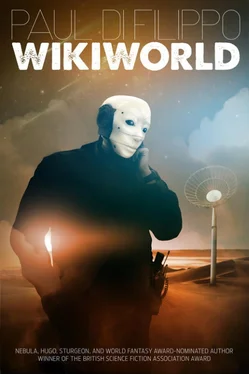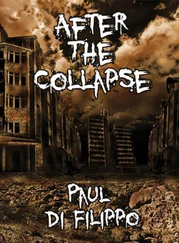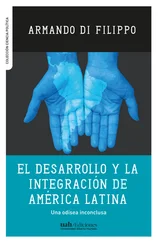Paul Di Filippo - WikiWorld
Здесь есть возможность читать онлайн «Paul Di Filippo - WikiWorld» весь текст электронной книги совершенно бесплатно (целиком полную версию без сокращений). В некоторых случаях можно слушать аудио, скачать через торрент в формате fb2 и присутствует краткое содержание. Город: Toronto, Год выпуска: 2013, ISBN: 2013, Издательство: ChiZine Publications, Жанр: Фантастика и фэнтези, на английском языке. Описание произведения, (предисловие) а так же отзывы посетителей доступны на портале библиотеки ЛибКат.
- Название:WikiWorld
- Автор:
- Издательство:ChiZine Publications
- Жанр:
- Год:2013
- Город:Toronto
- ISBN:978-1771481557
- Рейтинг книги:4 / 5. Голосов: 1
-
Избранное:Добавить в избранное
- Отзывы:
-
Ваша оценка:
- 80
- 1
- 2
- 3
- 4
- 5
WikiWorld: краткое содержание, описание и аннотация
Предлагаем к чтению аннотацию, описание, краткое содержание или предисловие (зависит от того, что написал сам автор книги «WikiWorld»). Если вы не нашли необходимую информацию о книге — напишите в комментариях, мы постараемся отыскать её.
WikiWorld — читать онлайн бесплатно полную книгу (весь текст) целиком
Ниже представлен текст книги, разбитый по страницам. Система сохранения места последней прочитанной страницы, позволяет с удобством читать онлайн бесплатно книгу «WikiWorld», без необходимости каждый раз заново искать на чём Вы остановились. Поставьте закладку, и сможете в любой момент перейти на страницу, на которой закончили чтение.
Интервал:
Закладка:
“Hush now,” said he, as if rediscovering his sense of modesty. “Not in front of Basil.” He raised his hands in a cautioning gesture—and suddenly his voice broke into that higher register again, amazed and exultant. “Look what we did!”
He now had seven fingers on each hand.
It was I who’d brought Mimi to Earth from the colony world of Omega, near the very heart of our galactic core. Her mother was an astrophysicist investigating the central black hole, and Mimi was a recent university graduate. Using a Wassoon information channel, she sent me a delightful little metasonata, very much in my own style. Extremely flattering, a seductive move.
It had been a simple matter for me to get the Supreme Bonze of the Archonate to grant Mimi Ultrapower a position at court. I’d anticipated some exciting interplay with her, but as soon as she met Anders, she was lost to me.
I tried telling myself I didn’t mind—I had my own women-friends after all, and if Mimi wanted to worship Anders, surely that was her own affair. The bottom line remained: she was an excellent metamusician, a good travelling companion, and a fierce street-hassler.
On that first Andromeda Galaxy tour together, we worked up a three-way collaboration, “Earth Jam,” in which Anders beamed out something like a flute part, I a kind of cello line, and Mimi zeepcast a kind of intricate percussion that was like a pounding headache—except that it felt good.
Understand that our audiences weren’t hearing our metamusic—it’s more that they could feel it in their souls, like the emotive shades of a daydream. Our symbiotic zeep colonies project our metamusic directly into the minds of those around us.
Originally the Uppytops used the one-celled zeep critters as a coercive tool to rein in their slave races. But humans ingeniously repurposed the zeeps for benign purposes.
Metamusic is inherently at its best face to face, in a live performance, with realtime zeep signals washing over the nervous systems of the audience—be they mollusks, apes, or insect hives. Although it’s possible to Wassooncast a copy of a metamusical performance, these copies are, in my opinion, like pulpy videos of the love act, utterly lacking the ineffable tones and subliminal frissons of the real thing. Yes, the masses watch the Wassoncasts, but if you’re an accomplished metamusician, you’re forever in demand as a touring artist.
After that first Andromeda Tour, we three had our customary debriefing with the Supreme Bonze, a taut-faced young man wearing a Tibetan-style hat with a yellow fringe along its top—not that he was Tibetan. His people were from Goa, the old Portuguese colony on the west coast of India.
Mimi stared at him in fascination. “Your hat…” she managed to say.
“The Black Hat,” said the Bonze. “Woven from the hairs of a thousand and one dakinis. You know of dakinis?”
“Oh, yes,” said Mimi, a knowing look on her pleasant face. “The ineffable female demiurges attendant upon the great gurus. What mana your Black Hat must have! Wearing it would confer mystical powers upon… upon even an ape! Not that I mean…”
“No offence taken,” said the Bonze, although his face belied this. “I’m eager to hear your group’s new piece.”
The Bonze purported to be a great devotee of metamusic, and always demanded that we perform our most recent road pieces for him, not that he had the mental force to pay proper attention.
But this time he was quite piqued by Mimi’s contribution to “Earth Jam.”
“ Buddoom bubba bayaya ,” he sang, as if trying to echo her signal in words.
“Well put, your Emptiness,” said I, before Anders could start arguing about the Bonze’s accuracy.
“Would you like my Black Hat?” the Supreme Bonze suddenly asked Mimi with a puckish smile. From my years at court, I knew this to be a trick question—anyone who expressed a desire for the Supreme Bonze’s Tibetan hat was beheaded. And the Bonze was in any case annoyed at Mimi for her remark about the ape.
I flashed her a zeep prod of warning; she was quick enough to understand.
“No, no, honourable Bonze,” said she, bowing nearly to the floor. “The Black Hat is in its proper place. Upon the emptiest head.”
That Mimi!
With our fame growing, Anders, Mimi and I obtained apartments in the Metamusic Academy, a lavish old building in downtown Lisbon, which had become the de facto capital of Earth. Anders had the top floor, I the floor below that, and Mimi a room below me. But she spent most of her time with Anders. She was teaching him about mathematical cosmology, of all things.
Mimi showed Anders how to rig up a Wassoon generator to make his apartment infinitely large along three dimensions, without quite piercing the barrier into the hyperdimensional subspaces involved in interstellar travel.
The jury-rigged generator was a clever little thing. At its centre was a tiny fringed ring like you might use for blowing soap bubbles—although the bubble-juice for this gizmo was an endlessly subtle fluid of unbound quarks. As each bubble appeared, a magnetronic tube would set up resonant vibrations, causing the bubble’s radius to oscillate. Wassoon’s genius lay in his breakthrough notion of allowing the delicate bubbles’ radii to oscillate down below zero and into negative values. As every schoolchild knows, a simple DeSitter transformation establishes that a quark bubble with negative radius is identical to a subdimensional cavity in space itself—and a cavity of this kind can readily become a gateway to the transfinite Wassoon spaces.
Playful as newlyweds in their first home, Anders and Mimi sent hallways running through the apartment forever, lamplit by a Wassoon energy-fractionating gimmick that could divide a hundred watts among an endless number of sympathetic bulbs. Clever Mimi even devised a procedural method for decorating the infinite areas of the endless walls with seemingly non-repeating tiles.
Anders was ecstatic over the infinite spaces of his apartment, and Mimi calmly said she’d known he’d like them, because in all his works he was trying in some fashion to create a direct view of actual infinity—whether as an endless regress, as a fractal elaboration, or as an impenetrable cloud of fuzz. She said that our universe itself was in fact infinite, although people tended to ignore this, blinded as they were by the background radiation of the most recent—what was the phrase she used? Not Big Bang, something else—ah, yes, Big Flash.
Sometimes, when I was loaded on zeep toxins, I’d go upstairs and look for the two lovers, pretending I had business to discuss. More often than not, they’d evade me, and I’d wake alone and hungover in some bare inner chamber, googolplex turnings deep into Anders and Mimi’s maze.
Upon arising, I’d seem to see shapes and faces at the inconceivably distant ends of the Wassoon hallways—creatures from earlier cycles of our universe, according to Mimi. Neighbours from before the Big Flash.
In any case, finding my way out was never hard. I merely followed the scent of my personal dissatisfaction and unease back to my own floor.
The zeep germs were our owners and our lovers, our sickness and our cure, our prison and our playground—a feverish buzz to the uninitiated, a language of power to the cognoscenti.
Each strain of zeeps was custom-designed from a core of basic Uppytop wetware modded with whatever odd mitochondria and Golgi bodies the composer could be induced to purchase by zealous ribofunkateers. The zeep colonies embossed our fingers with glowing, colourful veins. But that was only the start. Every metamusician—save Anders—constantly sought improvements in his or her system, striving to push ahead to new metamusical territory, to be the first to explore and domesticate uncharted realms of multisensory rhythm space.
Читать дальшеИнтервал:
Закладка:
Похожие книги на «WikiWorld»
Представляем Вашему вниманию похожие книги на «WikiWorld» списком для выбора. Мы отобрали схожую по названию и смыслу литературу в надежде предоставить читателям больше вариантов отыскать новые, интересные, ещё непрочитанные произведения.
Обсуждение, отзывы о книге «WikiWorld» и просто собственные мнения читателей. Оставьте ваши комментарии, напишите, что Вы думаете о произведении, его смысле или главных героях. Укажите что конкретно понравилось, а что нет, и почему Вы так считаете.










